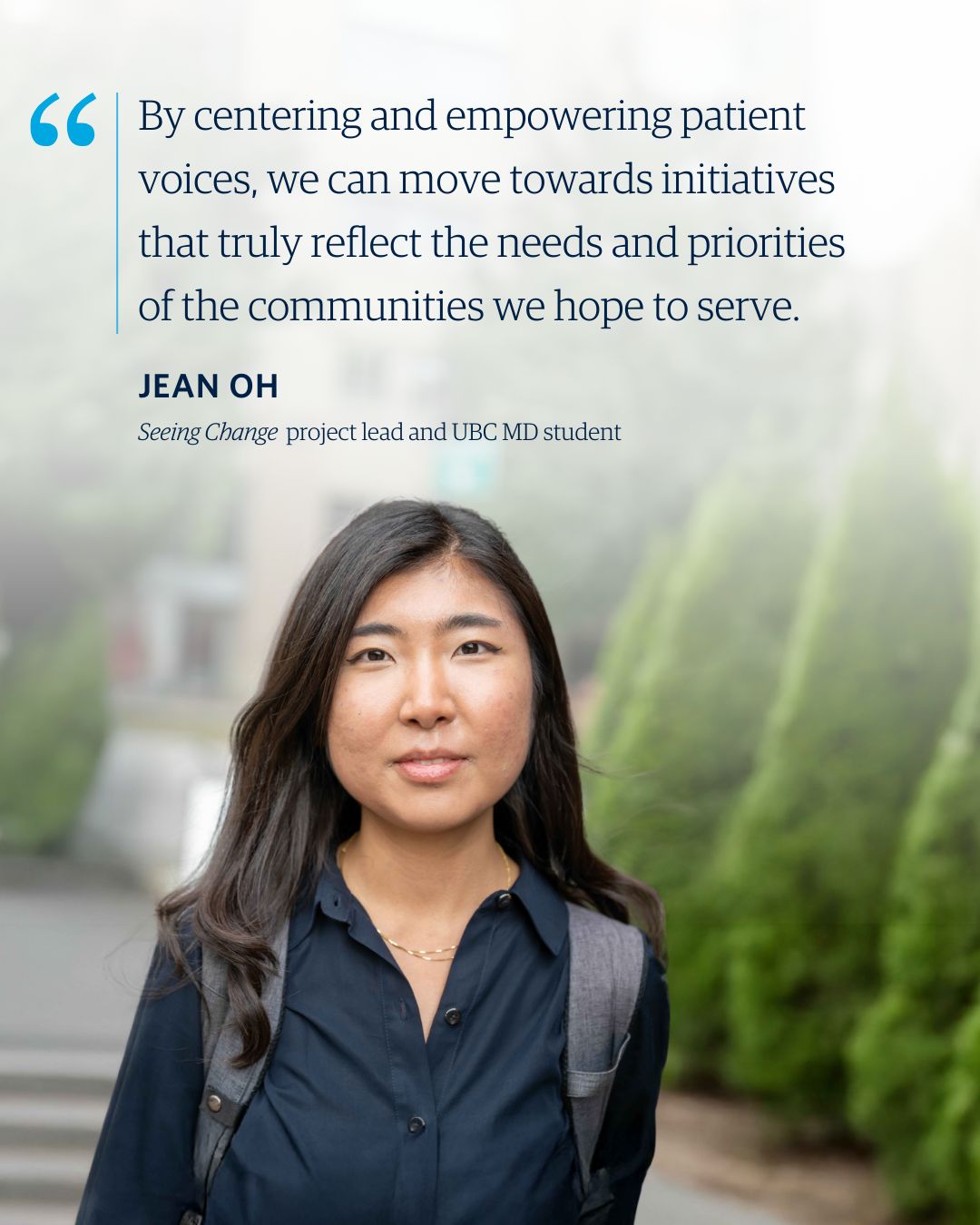This blog post was written by Jean Oh, a medical student at the University of British Columbia, who led the partnership project between Indigenous Elders and UBC Vision Cluster collaborators.

The “Seeing Change” project was awarded the UBC Community-University Engagement Support (CUES) Fund in February 2025. This initiative explores Indigenous patient experiences with eye care in Vancouver’s Downtown Eastside (DTES), guided by the leadership and stories of our patient partners. The lessons we gather will inform long-term initiatives co-led by Elders, community members, DTES Eye Clinic (DEEC) health care providers, and UBC researchers.
Click here to read the full news story
Witnessing loved ones live through vision loss is not a unique story. As a child, one of my most vivid memories was seeing my grandmother, who once walked me to school, cooked family dinners, and played the piano with me, breaking down after losing the vision that had enabled those moments. At the time, I could not grasp the weight of what she was experiencing. But as I grew older, I came to appreciate how profound and universal the loss of vision can be, and how much it shapes identity, independence, and connection. This early experience sparked my interest in ophthalmology: a field that allows us not only to preserve vision but also to listen to patients’ stories and support them through life-changing transitions. Entering medical school only deepened this interest, as I saw firsthand how the need for eye care collides with the strain on our healthcare system.
The DEEC was designed to bridge these gaps for the DTES population, many of whom depend on their vision to navigate a complex and unstable environment. At this non-profit clinic, staffed by deeply compassionate providers, referrals are often seen within weeks. Yet during my time as a volunteer, I saw days when nearly half of scheduled patients missed their appointments. It was not until I began speaking with patients that I understood the deeper causes: the intersecting effects of colonialism, racism, and poverty, barriers that disproportionately affect Indigenous patients in particular.

Around this time, I learned of a project developed by Vision Cluster members and partners Dr. Ruanne Lai (Research and Knowledge Translation Facilitator), Dr. Laura Bulk (Assistant Professor of Teaching in the Department of Occupational Science and Occupational Therapy), Dr. Angela Chang (optometrist and former DEEC Clinical Lead), and Dr. Zaid Mammo (Clinical Assistant Professor in the Department of Ophthalmology and Visual Sciences and DEEC Co-Director). Their aim was to hear directly from Indigenous patients about their experiences with eye care through a series of focus groups. With their encouragement, I proposed approaching the work through a more community-led lens, rooted in reciprocity, trust, and long-term relationship-building.
I was connected to Dr. David Tu, primary care physician at Kílala Lelum, and subsequently Elder Sandy Lambert, Elder in Relational Care at Kílala Lelum. Over tea at JJ Bean, we spoke about trust, storytelling, and what it means to do research in a “good way”. We reflected on how many studies collect data, publish findings, and move on, often without returning to the people who shared their knowledge. Under his guidance, we envisioned something different: a project grounded in accountability, cultural safety, and care.
Our first focus group was held shortly after, facilitated by Elder Sandy and attended by four Indigenous patient partners, two of whom continue to guide the project today. We moved thoughtfully holding space for reflection. I learned how the experience of being Indigenous and living in the DTES often comes with stigma before a word is even spoken. We discussed the emotional toll of navigating fragmented systems while living with chronic eye conditions. We also spoke of hope: the difference that culturally humble, respectful providers can make, and the importance of being seen.
As a medical student, I have been taught by many brilliant educators, but few experiences have shaped me as deeply as sitting in that circle. Amid pain and frustration, I was privileged to witness the strength and insight of patients who continue to advocate for themselves and their communities. With their guidance, we submitted an application for CUES funding to hold further discussions and pursue community-led initiatives, and in February 2025, our project was awarded.
Since then, we have held further focus groups where ideas for initiatives such as outreach eye health days hosted at Indigenous-centered primary health care settings have emerged. The goal remains to build trust and relationships between patients and eye care providers, creating more culturally safe pathways to care. We continue to centre and uplift the voices of our patient partners, ensuring they guide the direction of our work.
This work has transformed how I understand healthcare. The core dream I carry, to guide people like my grandmother through vision-impairing conditions, remains unchanged. What has changed is my understanding of my role. It is not always to lead, but often to create space. When patients are given that space, whether in research or in care, what emerges is not only insight but possibility.
To deliver meaningful care, we must move intentionally, build trust, and remain in relationship with the communities we serve, such as the DTES. As a future physician, I aspire to carry this approach forward: collaborating with patients in the clinic through meaningful relationships, and in research by ensuring their voices shape the questions we pursue and the outcomes we discover.
I am deeply grateful to our patient partners, Elder Sandy, our clinical and research teams, and the CUES Fund for making this work possible.